Berlin
The week after my birthday, we decided to take another trip into Germany, this time to Berlin. Berlin has been one of the coolest cities I’ve ever visited, and once again I walked away with a much broader understanding of Germany’s history.

We pulled into Berlin around 8am on a Friday. The first thing on our agenda was finding the hostel to check-in and drop off our bags, as usual. So we hopped on a train that was obviously a relic from East Berlin’s communist past and thought that it would take us to where our hostel was in a few short stops. I suppose I should have realized that no one else was on the train, but sleep-deprivation can do something to a person. We only pulled up to one stop, and no-one else got on there, but an old German man did take the time to open the doors and yell at us, something which we probably should have taken as a warning for what was to come. There was not another stop. We pulled into a train graveyard of sorts, and I honestly thought that this was it. No more Berlin for Rachel, just endlessly and desperately pressing every red button in this communist-era train car in its creepy East Berlin train graveyard for the rest of my life. Luckily, the new conductor appeared at the window, boarded our car, and told us to sit down and to stop trying to call the Berlin police. In a few minutes we were headed in the other direction, and all was well.
Our hostel was the Amstel House. Although a little out of the way, it perfectly suited our needs. To start with, we rented a quadruple room for €50/night. Affordability? Double-check. The hostel also had free wifi, but only in its common area which was a perfect blend of a dining hall, bar, and living room. While I initially thought this was quite inconvenient, I eventually learned to love it. Every guest in the hostel seemed to be downstairs in the evenings, and that made for excellent people watching. There were school groups, and families, and independent travelers. By our second night at the Amstel House, I was quite thankful that they had essentially forced us to acknowledge our fellow travelers.

We spent our first day in Berlin wandering the Tiergarten. The Tiergarten is like a more historically relevant Central Park on steroids. Originally a hunting reserve in which deer, wild pigs, and other game were kept, it was transformed into a park in 1700. Designed originally in French style, it was later converted into an English-style landscaped park. The Tiergarten covers some 520 acres and is a favorite spot for relaxation, walking, and boating for locals and tourists alike. It was beautiful even in the winter, and we spent a significant amount of time admiring all sorts of monuments. We saw statues of Otto von Bismarck, Frederick Wilhelm III, and Queen Luise. The most impressive monument by far was the Soviet War Memorial. The park is crowned by the Berlin Victory Column, the most important of the Tiergarten’s monuments. The column, built in 1873, is an outstandingly beautiful 70-meter-tall structure built on a roundabout and crowned by an eight-meter-high gold statue of Victoria (nicknamed Golden Lizzy by locals). Apparently you can climb the stairs all the way to the top for an awesome view of the Tiergarten in its entirety. I believe I will save that activity for a warmer and less windy visit to Berlin.

We planned to take a free tour of Berlin, again with Sandeman’s New Europe, on our second day in Berlin. We also went on Sandeman’s free walking tour in Munich, and it was incredible. We figured we would stick with them again in Berlin. We got lucky, because our tour guide turned out to be absolutely incredible. We started our tour at the Brandenburg gate, obviously an incredibly historically relevant site. Our guide pointed out the brick line in the road, indicating where the Berlin wall used to divide the city.
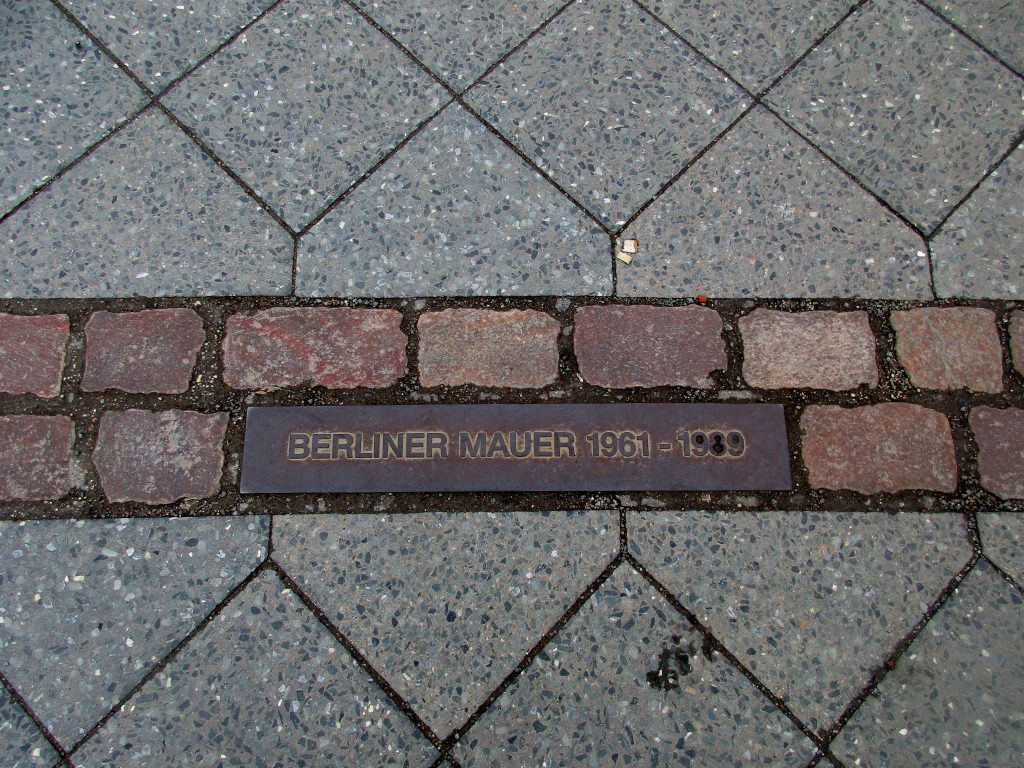
The Brandenburg Gate is an 18th-century neoclassical triumphal arch in Berlin, and one of the best-known landmarks of Germany. It is built on the site of a former city gate that marked the start of the road from Berlin to the town of Brandenburg. It was commissioned by King Frederick William II of Prussia as a sign of peace and built by architect Carl Gotthard Langhans from 1788 to 1791.The Brandenburg Gate suffered considerable damage in World War II. It was finally fully restored from 2000 to 2002 by the Berlin Monument Conservation Foundation. During the post-war Partition of Germany, the gate was isolated and inaccessible immediately next to the Berlin Wall. The area around the gate was featured prominently in the media coverage of the tearing down of the wall in 1989, and then the German reunification in 1990. Throughout its existence, the Brandenburg Gate was often a site for major historical events and is today considered a symbol of the tumultuous history of Europe and Germany, but also of European unity and peace.
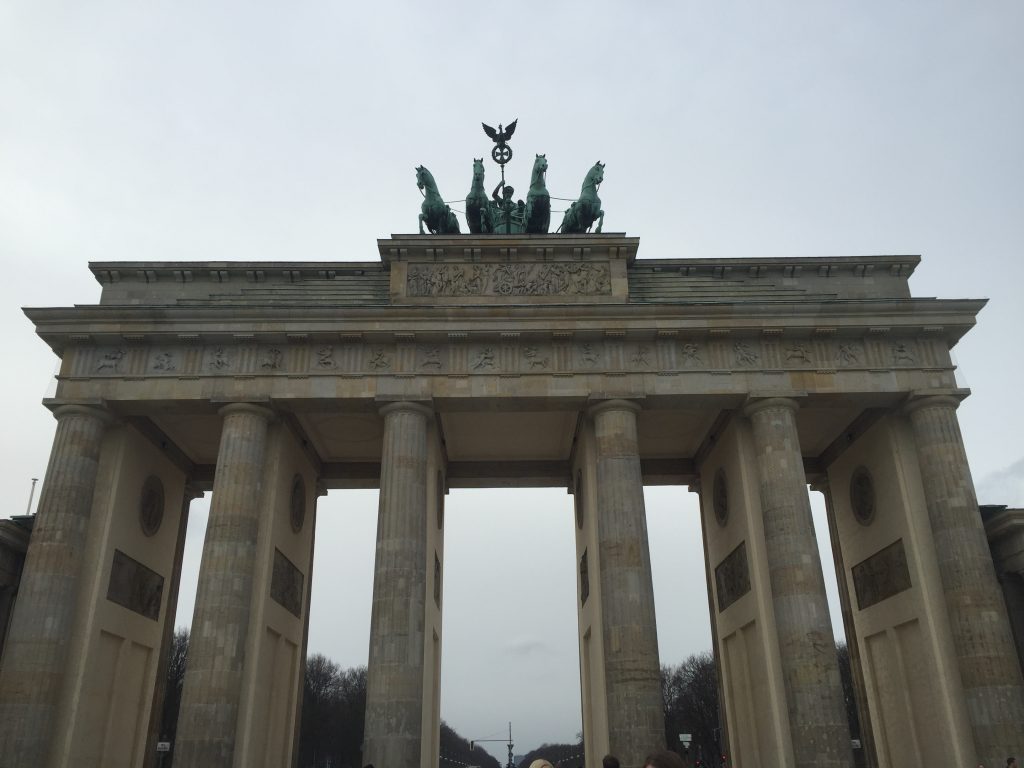
After our time at the Brandenburg Gate, we ventured over to Berlin’s Memorial to the Murdered Jews of Europe. It’s a striking and sprawling structure that we had already passed by but knew nothing about. We had, however, visited the museum built directly beneath the monument, which was enlightening and haunting as always. Our guide explained that the monument had been built by architect Peter Eisenman and engineer Buro Happold in 2004. The architect has never definitively explained the symbolism behind the monument, instead leaving it open to interpretation. To me, it looks like an endless sea of graves growing taller and taller towards the middle. The site is covered with 2,711 slabs of concrete, or “stelae” on a sloping field, and no two slabs are the same. Many believe that the stelae were designed to produce an uneasy, confusing atmosphere, and the whole sculpture aims to represent a supposedly ordered system that has lost touch with human reason. Whatever the interpretation, the memorial is both imposing and thought-provoking.

Next, we visited what appears to be a typical parking lot. Underneath, however, lie the remnants of Hitler’s final hiding place and site of his suicide, the Führerbunker. The Führerbunker was an air-raid shelter located near the Reich Chancellery in Berlin. It was part of a subterranean bunker complex constructed in two phases which were completed in 1936 and 1944. Hitler took up residence in the Führerbunker on January 16, 1945 and it became the center of the Nazi regime until the last week of World War II in Europe. After midnight on the night of April 29, Hitler married Eva Braun in a small civil ceremony within the Führerbunker. Afterwards, Hitler took his secretary to another room and dictated his last will and testament. The next afternoon, Hitler committed suicide alongside his new life. In accordance with Hitler’s instructions, the bodies were burned in the garden just outside the entrance to the bunker. In accordance with Hitler’s last will and testament, Goebbels became the new Head of Government and Chancellor of Germany. Goebbels killed himself and his family at the bunker the next day, and the army surrendered soon after.

Although there were numerous attempts at demolition by dynamite after the war, the underground complex was essentially indestructible and remained largely undisturbed until 1988–89. During reconstruction of that area of Berlin, the sections of the old bunker complex that were excavated were for the most part destroyed. The site remained unmarked until 2006, when a small plaque with a schematic diagram was installed. Some corridors of the bunker still exist but are sealed off from the public. Government authorities wanted to destroy the last vestiges of these Nazi landmarks. The construction of the buildings in the area around the Führerbunker was a strategy for ensuring the surroundings remained anonymous and unremarkable. And this is how the final resting place of National Socialism came to be occupied by a parking lot. It was deeply satisfying to stand atop of the grave of the Nazi movement, and I’m beyond thankful that our guide took the time to show us this important historic site.

Our guide also took the time to give us some background information on an essential structure on Berlin’s skyline. The Berlin TV Tower was constructed between 1965 and 1969 by the administration of the German Democratic Republic. It’s original purpose was to block Western Germany’s radio waves from reaching East Berlin. It is now an important symbol of Berlin, and it is easily visible throughout the city. With its height of 368 meters, it is the tallest structure in Germany, and the second tallest structure in the European Union.

The Gendarmenmarkt is a square in Berlin and the site of the architectural trio of the Konzerthaus (concert hall) and the French and German Churches. In the center of the square stands a monumental statue of Germany’s renowned poet Friedrich Schiller. During World War II, most of the buildings were badly damaged or destroyed. Today all of them have been restored. The square was one of the most beautiful and architecturally significant in all of Berlin.
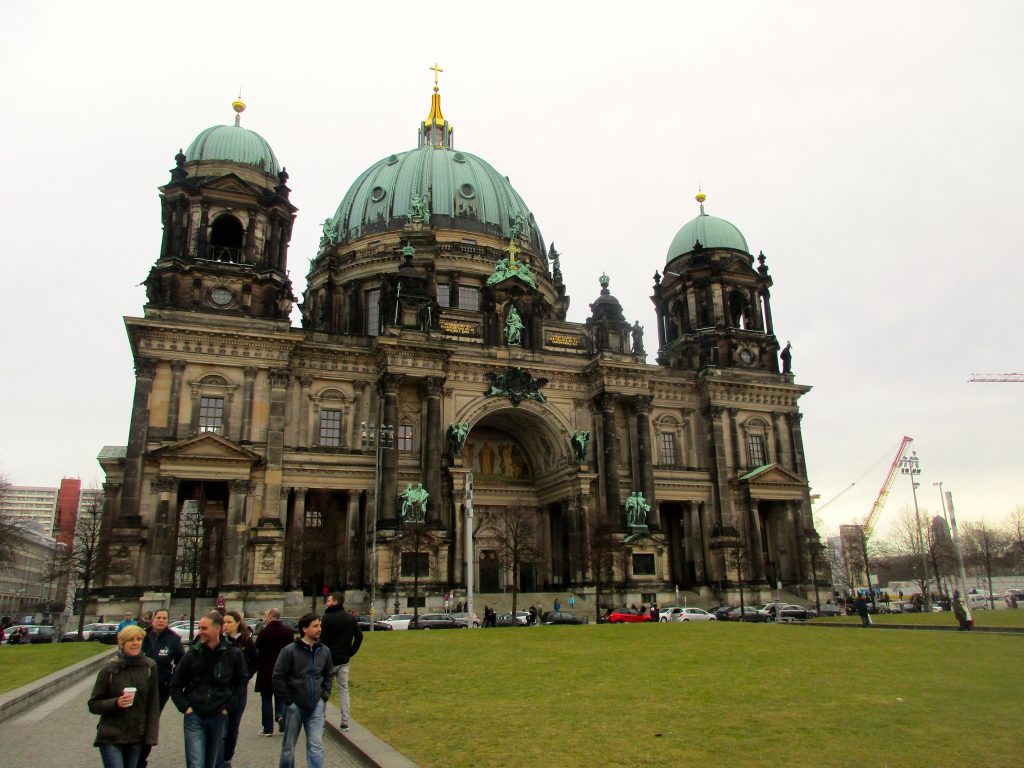
Our last stop on the tour was Museum Island and the Berliner Dom. Museum Island is the name of the northern half of an island in the Spree river. It is home to five internationally significant museums: the Altes Museum (Old Museum) completed in 1830, the Neues Museum (New Museum) finished in 1859, the Alte Nationalgalerie (Old National Gallery) completed in 1876, the Bode Museum on the island’s northern tip, opened in 1904, and the Pergamon Museum, the final museum of the complex, constructed in 1930. In 1999, the museum complex was added to the UNESCO list of World Heritage Sites.
The Berlin Cathedral, or the Berliner Dom in German, also calls Museum Island its home. Despite how ancient it may look, the Cathedral was only completed in 1905. Constructed in the Neo-Renaissance style, it is Berlin’s largest and most prominent Protestant church. King Frederick William IV decided that a magnificent cathedral should be built after becoming jealous of the extravagant cathedrals of his fellow rulers in the area. It is now one of the most visited sites in the city.
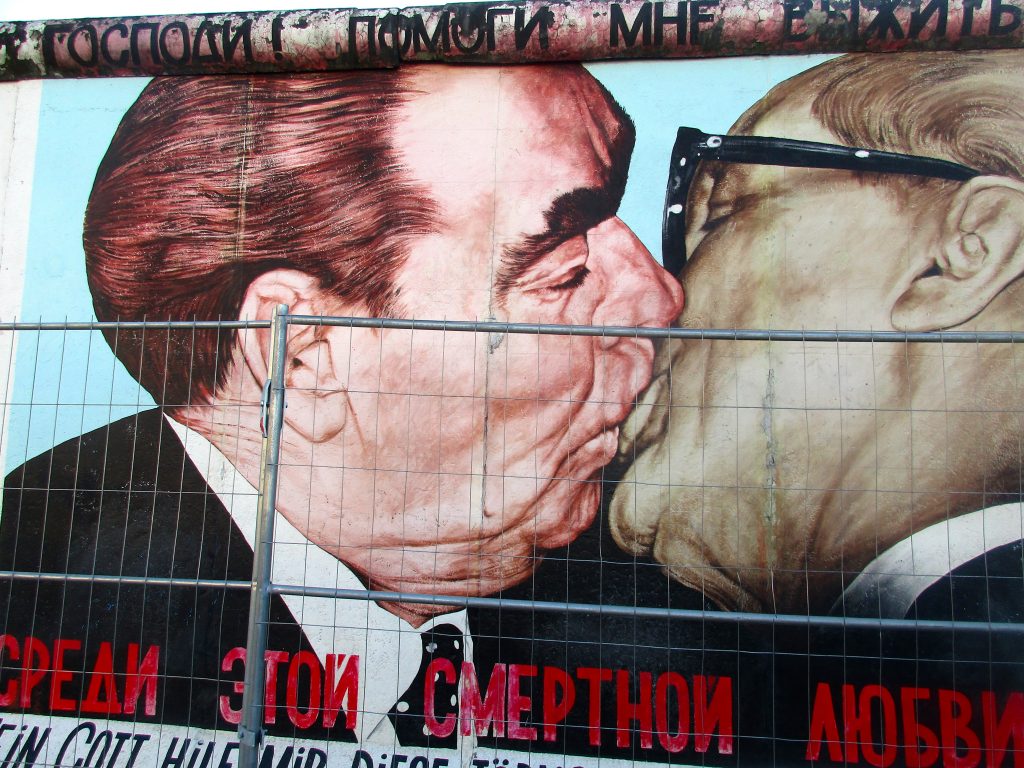
On our last day in Berlin decided to spend a good deal of time exploring the East Side Gallery. The East Side Gallery is an old part of the Berlin Wall that now stands as an international memorial to freedom. The Gallery consists of 105 paintings by artists from all over the world, painted in 1990 on the east side of the Berlin Wall. It is potentially the largest and longest-lasting open-air gallery in the world. The paintings at the East Side Gallery document a time of change and express the euphoria and great hopes for a better, more free future for all people of the world. We walked along the wall and then along the river and enjoyed a beautiful day admiring the thought-provoking art and historical significance of the gallery.

I wasn’t expecting to enjoy Berlin nearly as much as I did. The city was beautiful and the tour was so incredibly helpful to my understanding of the history of the region. Berlin now sits close to the top of my list of my favorite cities of Europe, and I know I’ll be back again to walk through the Tiergarten and admire the East Side Gallery.

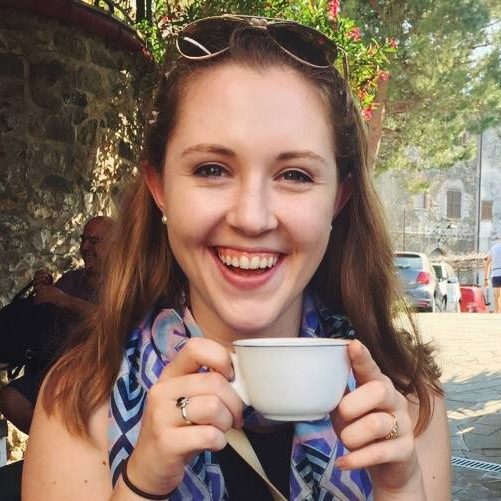
Rachel is a Strasbourg alumna, dog mom, and bona fide politico. While on study abroad, she wrote for the University of Florida “Global Gators” blog and later served as an On-Campus Ambassador for the CEPA Foundation. She has since completed her Bachelor with a double major in Political Science and Economics at UF and now works in DC as a Staff Assistant in the US House of Representatives.